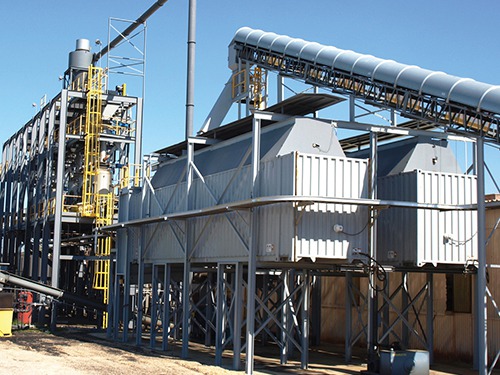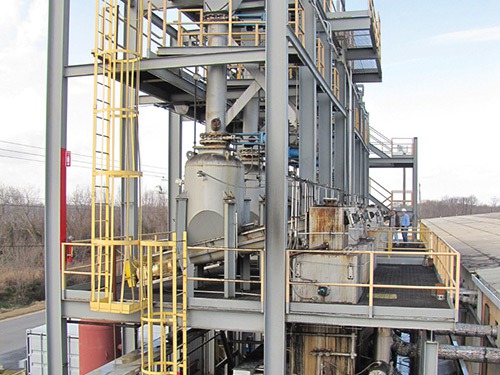Process Heat Gas (PHG) Downdraft Gasifier, Boiler or Generator Set
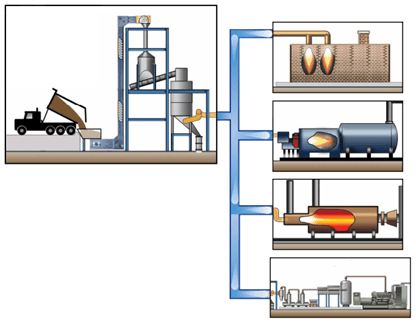
The PHG Reactor is a patent protected breakthrough technology in downdraft gasification. This carbon neutral green product is the centerpiece of the Effect - Operational Sales Group renewable product offering.
This is simply the best turnkey energy generation system technology available in the market place.
Customers have the ability to configure a system to fuel their specific industrial or institutional energy needs, and to scale their equipment depending on the size of those requirements. Municipalities, resorts, industrial facilities, utilities and waste management entities need to consider this clean conversion system because it can produce energy as a most economical and worthwhile alternative to fossil fuels and nuclear power. The PHG Reactor is a prime example of an energy efficiency product that positively impacts Energy, Economy and Earth.
Understanding the individual requirements of customers' systems enables us to recommend equipment and configuration that will provide a consistent supply of affordable and renewable energy for many decades to come.
Call 1-800-701-2963 to have our engineers apply downdraft gasification to your energy needs.
Custom Applications
Site Surveys
The PHG downdraft gasifier can be provided as a turnkey system to meet the specific needs of clients. We’ll consider your current operations and configure a system that will integrate seamlessly. Our site survey will effectively assess:
- MMBTU fuel requirements
- Feedstock availability, mix and sourcing options
- Preferred equipment
- Logistics supply configurations and storage
- Facilities design
- Construction needs
- Producer/synthetic gas chemical properties required for work throughput
- Recycling channels
Project Management Team
Our project management, financial planning and engineering team will also provide expert assistance in applying downdraft gasification to your specific energy needs.
Process Heat Gas Applications
The following figure shows possible PHG downdraft gasifier applications:
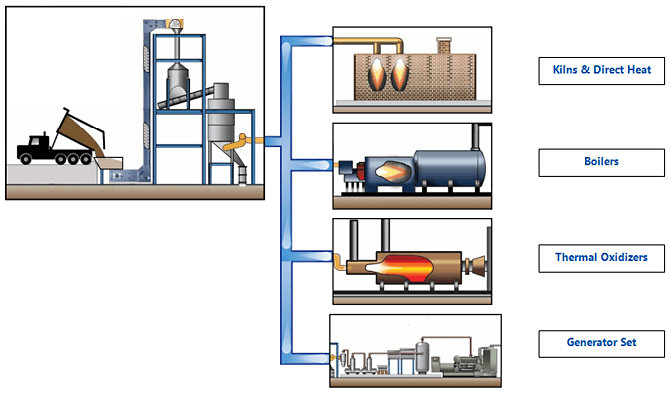
Kilns and Direct Heat
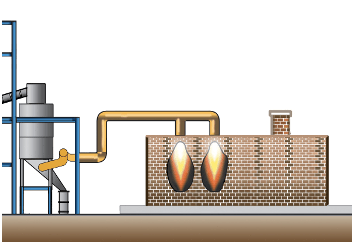
Brick, ceramic tiles, and wood kilns, as well as cement drying operations, typically consume natural gas or wood waste to produce the required thermal input to fire or dry their products. Producer Gas can displace the entire current fuel source, or a portion of it, depending on the customer’s need.
Boilers
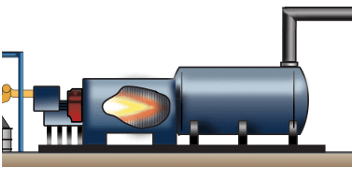
Conventional boilers, whether for industrial or institutional use, are excellent candidates to consume Producer Gas. Just as in kiln or direct heat applications, the volatile gas resulting from downdraft gasification can be piped into the boiler or adjacent burner box to add to the hot flue gases and partially displace the need for existing fossil fuels. Adaptors will find that the tailpipe emissions from Producer Gas are very similar to natural gas and much cleaner than coal. Over firing a coal-burning boiler with Producer Gas could offer future Carbon Credits, less expensive Btu input to the boiler, and would help to burn off coal-produced particulates thus lightening the load on the downstream emission components associated with the power plant. Institutions such as colleges and universities, hospitals and military bases should consider implementing conversion to renewable fuel sources.
Thermal Oxidizers
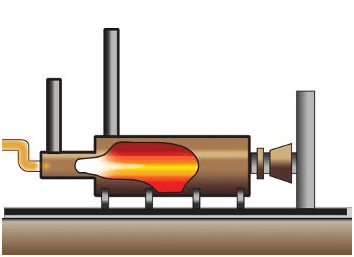
Many industries are required to employ thermal oxidizers in their exhaust stream to burn off Volatile Organic Compounds (VOCs). Examples of current users include paper and cardboard producers, pressboard and engineered wood manufacturers, and paint booth operations.
Typically fired by natural gas, these emission-reducing devices are excellent candidates for the use of more economical and renewable Producer Gas to replace some or all of their fossil fuel consumption. Many users already have feedstock available as waste or a by-product of their current manufacturing processes.
Electrical Generation
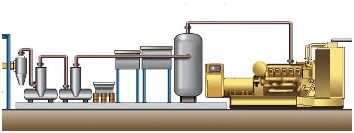
A generator set can also use refined Producer Gas in internal combustion engines (both reciprocating and combustion turbines). This technology is offered in megawatt-sized generators. New processing skid technology is being employed to clean and cool the Producer Gas, and allow direct injection into these engines. Once these internal combustion engines are tethered to generators, they can supply the electrical needs of institutions, industry, or the electric grid.
Biomass & Feedstock
True-Green Energy System
The Producer Heat Gas (PHG) reactor product offered has been thoroughly tested and proven in industrial applications. Biomass and other feedstock to fuel the process are readily available and renewable. Solving the scaling issues that confined the previous downdraft configurations to small residential and automotive use has allowed this PHG reactor to move effectively into large industrial applications to positively impact Energy, Economy and Earth.
Pollution from the gaseous fuel production process is practically non-existent. The resulting fuel burns as cleanly as natural gas. The next generation of biofuels reactors is here. Companies adapting this technology will be leaders as the movement toward a true-green energy economy continues. They will be true stewards of our environment because they will have chosen to deploy and commission renewable, environmentally friendly and economically viable system technologies.
Renewable and Sustainable Fuel Sources
The use this modern downdraft gasification technology allows the use of a flexible array of feedstock for conversion to combustible gaseous fuel for kilns, boilers or electric generation. The choice of feedstock is a critical element in the economic analysis of the planned installation, and in the design and construction of the mechanical and control equipment to fuel the recommended gasification equipment. Assisting customers in choosing and sourcing suitable and renewable local feedstock is an important part of the overall service provided. Our Project Management Team can provide assistance to users in the procurement, contracting and price forecasting of feedstock, although in some instances acceptable feedstock is readily available as a product of the customer's ongoing industrial, waste management or manufacturing operations. The PHG reactor offered can effectively use
- Wood chips, bark or other forest product waste
- Scrap tires and rubber products
- Processed municipal waste
- Manufacturing scrap, pallets and other by-products
- Agricultural biomass and waste
- Coal
- Etc.
PHG Work Throughput
The work throughput of this PHG Reactor consists of 98% producer gas and 2% biochar. Further analysis and projections provided by our team will assist customers in determining likely uses for the small amount of biochar residue resulting from the downdraft gasification process. While such high-carbon content char is relatively small in volume, it has been shown to have economic value for soil conditioning and other applications where activated charcoal is required.
Feedstock Specifications
- Dimensions: Between 3" and 1/8" (any direction)
- Moisture Content: 30% by weight or less (wet basis)
- Minimum Density: 14 lbs per ft3 (wet basis)
- Heat Value: 6,520 btu/lb minimum, wet basis
- Minimum Biomass Content: 60% of the weight of the feedstock (dry basis)
- Maximum non-volatile concentration (solids): 5% by weight (dry basis)
Benefits
Strong Direct Economic Impact for the Process Heat Gas (PHG) reactor
Utilizing readily available renewable fuel sources to replace or augment burning of fossil fuels gives customers immediate bottom-line results and positions them for the global shift to renewable energy. While every project differs in scale, feedstock source, and application, the PHG Reactor Team's installation experience and ongoing research provide a strong foundation to address the challenges of renewable energy projects. A critical segment of the Effect – Operational Sales Group product offering is a site survey encompassing a detailed study of current energy usage and costs to quantify the full economic benefits of PHG reactor technology.
PHG Reactor versus Natural Gas in a Direct Heat Kiln or Boiler
A customer who is currently purchasing natural gas at a delivered cost of $8 per million BTUs (mmbtu) can reduce equivalent fuel cost to $2-4 /mmbtu by purchasing wood chips at $30/ton and applying PHG's gasification process. Fuel costs are reduced up to 75%. The Return on Investment (ROI) simple payback for installation, operation and maintenance of the new system can occur in four years and is paid directly from ongoing fuel savings. Carbon credits or carbon tax reductions could also further improve the economic payback of the project.
PHG Reactor versus Coal in a Boiler
Use of Producer Gas in a coal-fired boiler could reduce fuels costs up to 50% when compared to today's market price for high-grade coal. For current coal users, an equally important consideration is NOx reduction from over firing the coal bed with Producer Gas. The gasifier process significantly reduces NOx and fly ash carryover to the boiler flue while also adding heat from the Producer Gas. This application dramatically reduces treatment requirements, costly permitted emission rates, and load on the exhaust stream emission equipment.
Electricity Generation
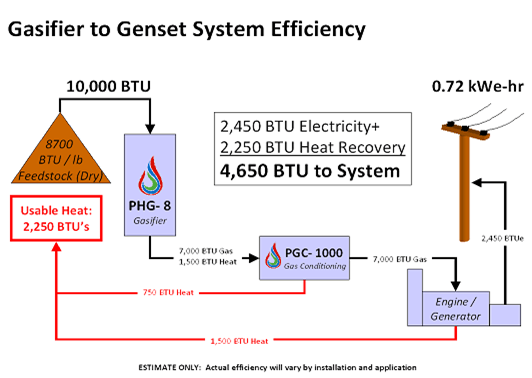
Further refinements of Producer Gas through the PGC-1000 processing skid technology allow direct injection into internal combustion generator engines. Securing feedstock at $30/ton will provide customers with a three-year equipment payback based on offsetting delivered electric costs of 14.2 cents per kilowatt hour. This estimate also considers maintenance and operating costs of the gasification system. Applying this direct generation capability in concert with a combined heat and power application can further improve efficiencies.
Financial Drivers
Beyond these basic economic examples there are important, if not critical, benefits our customers gain from modern gasification technology. For instance, in the electrical generation application, a Federal program exists that can pay a qualified customer an additional $.011 per kWh as a production tax credit for open loop biomass production and $.022 for a closed loop process. Gasifier-based renewable fuel sources are the most plentiful and cost effective carbon neutral alternatives and, similar to solar and wind, are unlikely to face any existing or new taxes or government-imposed limits or regulations. Future actions regarding Cap and Trade or carbon taxing can only increase the value of gasification using renewable and sustainable sources.
Understanding the individual requirements of customers' systems enables us to recommend equipment and configuration that will provide a consistent supply of affordable and renewable energy for many decades to come. We can also seek available incentive program benefits to help you meet your sustainability and renewable energy goals.
Call 1-800-701-2963 to have our engineers apply downdraft gasification to your energy needs.
Engineering Perspective
The Producer Heat Gas (PHG) reactor is a low-tar biomass sequential, co-current flow, gravity-assisted, thermo-chemical phase change reactor or, more simply put, a revolution in biomass gasification
PHG Gasification Technology that:
- Creates a synthetic fuel called Producer Gas which can be piped to existing equipment where it is fired in direct heat processes such as kilns, boilers and thermal oxidizers, or refined further to produce a cleaner form of fuel for other industrial applications such as internal combustion engines for electrical generation.
- Utilizes a wide range of renewable and readily-available biomass, such as wood chips, processed municipal solid waste, agricultural waste, construction waste, and a wide range of other feedstock to yield the clean-burning Producer Gas.
- Allows users to substitute less expensive renewable fuel for natural gas, saving up to 75% of energy cost in some applications.
- Provides an economically sound and environmentally sensible alternative to non-renewable fossil fuels, such as diesel oil and coal, without the emission problems typical of those fuels.
- Protects users from fossil fuel shortages and unpredictable price increases.
- Positions adaptors favorably for regulatory actions involving Renewable Portfolio Standards, Carbon Caps and Trades, or Carbon Taxes and allows them to capitalize on the production and investment tax credits.
- Produces almost zero pollution during the solid-to-gas conversion process, and the resulting Producer Gas burns as cleanly as natural gas in most applications.
- Provides a small amount of recyclable by-product, known as biochar, which is easily manageable, carbon rich and has value for further use.
Proven New Gasification Technology
It took 10 years Research and Development (R&D) to design, build and successfully deploy and commission this new downdraft gasification system. Now this proprietary energy efficient technology can be used in multiple industrial applications. While downdraft technology has been in public use for at least 75 years, the industry has struggled to scale up this process for industrial application. The recent release of the PHG line of gasifiers shifts that paradigm by offering scalable downdraft gasification solutions. There are currently 4 models within the PHG (Process Heat Gasification) line of gasifiers: the PHG-8, PHG-12, PHG-32 and PHG-64.
| Model |
Feedstock tons per day (Approximate) |
Heat output per hour (MMBTU/HR) |
Availability |
|---|---|---|---|
| PHG-8 | 8 | 4 | Now |
| PHG-12 | 12 | 6 | Now |
| PHG-32 | 32 | 16 | January 2012 |
| PHG-64 | 64 | 32 | July 2011 |
Gasification Process and Operations
The units are designed in a modular format allowing a customer to apply multiple units to reach their individual needs for gas utilization. There is no burning stage in the downdraft gasification process. The conversion process builds up heat while restricting oxygen to block combustion, allowing a low-pressure, thermo-chemical solid-to-gas phase change reaction to occur. This high efficiency conversion of chemical potential energy within the feedstock creates the Producer Gas for use in conventional kilns, boilers and electrical generation equipment.
The PHG system produces a self-cleaning Producer Gas stream through the gravity-assisted separation of particulates, metals, and condensation from the fuel. The resulting biochar is approximately 2% by weight of the feedstock initially used, is very manageable and has practical uses (including soil conditioning and filter media). This minimizes or eliminates waste disposal requirements.
The downdraft technology employed by PHG produces a much cleaner Producer Gas compared to other gasifier configurations. This greatly reduces the need to clean the gas, an inherent problem typical in fluidized bed or updraft gasifiers. Minimal energy is expended on the parasitic loads within the gasification and conditioning system maximizing the output capabilities of the gasifier.
The safe, enclosed system is fully automated and can operate unstaffed for extended periods of time. The computerized control system will alert both on-site attendants and remote monitors to potential problems, allowing corrective action and minimizing downtime maintenance.
Multiple PHG units have proven to work well in parallel with each other, taking advantage of a single feedstock supply and control system to provide a customized supply of Producer Gas to meet the precise needs of the customer.
Conditioning Skids for Sensitive Applications
For applications that demand the cleanest fuel, such as internal combustion engines, the product clean-up skid components boast three additional stages:
Large Particle Separation - Large residue particulate is accomplished first by gravity separation in the residue box of the reactor and secondly by polishing in a refractory-lined gas cyclone. This equipment is designed to capture 95% of particulate matter 10 microns and larger.
Organic Phase Scrubbing and Cooling - The polished hot producer gas is rapidly quenched by a stream of mineral oil or other hydrocarbon solvent to capture any remaining particulate matter and to absorb heavy tars. The oil is maintained at between 270°F and 310°F by fin-fan air cooling to prevent the condensation of water. A start-up heater is included. Periodically, a quantity of the solvent is recycled back to the gasification reactors and fresh solvent is added to the system. The quantity of solvent consumed is dependent on the feedstock moisture content and chemical make-up.
Aqueous Phase Scrubbing and Cooling - After scrubbing with the organic phase, the producer gas is rapidly quenched by a circulating cooled water stream. This second scrubber further removes any residual particulate material and condenses the steam within the producer gas. The producer gas from the scrubber flows into a gas coalescing accumulator. For short pipe runs from the accumulator to the engine intake, heat tracing on the outlet pipe can be used to prevent water condensation of the saturated producer gas. For longer pipe runs a water chiller is recommended to sub-cool the incoming producer gas to 80% relative humidity or less.
The end result is a renewable producer gas suitable for even the most sensitive applications.
Should you wish to conduct a site visit of an operational PHG reactor facility, do not hesitate to contact us.
Call 1-800-701-2963 to see just how operationally effective these PHG reactors can be.
